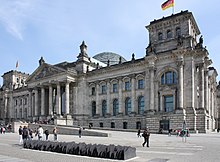Guido Heym
Guido Heym (born May 1, 1882 in Suhl ; † April 5, 1945 near Tiefurt , district of Weimar ) was a socialist politician and journalist. Heym was murdered by the SS in 1945 .
Life
Heym, who a social-democratic oriented worker's family came, worked after school as a toolmaker and in 1897 the castle German Metalworkers' Federation and 1901 the SPD on. In 1910 he began to write for social democratic newspapers, in 1913 he took over the local party bookshop, acted as local editor for the Erfurt SPD newspaper Tribüne and was elected to the city council. Called up for military service ( Landsturm ) in 1915 , Heym was a soldier until 1918, and in 1917 he and his father joined the USPD , which he represented in the district council and state parliament of the province of Saxony after the November Revolution .
With the left wing of the USPD, which united with the KPD at the end of 1920 , Heym came to the VKPD , in the following years he was also editor-in-chief of the local KPD newspaper Volkswille , parliamentary group chairman in the city council (where the KPD was the strongest parliamentary group) and Chairman of the local association. Belonging to the left wing of the party around Ruth Fischer and Arkadi Maslow , Heym was elected to the Reichstag in May 1924 and to the Prussian state parliament in December 1924 . Even after Fischer and Maslow were removed from the party leadership, the KPD in the Suhl sub-district remained on the side of the party left and after the expulsion of Fischer, Maslow, Werner Scholem and Hugo Urbahns in 1926, it was only formally part of the KPD because of its strength Heym was only excluded from his position in the Suhl region in December 1927, when he announced that the will of the people would now become the nationwide organ of the Left Opposition. Eleven out of twelve city councilors and the majority of the local association followed Heym and joined the Lenin League .
Shortly before the Reichstag election in 1928 , Heym left the Lenin League again with most of his supporters, the main reason probably being the assessment that the organization had no great future, as well as the fear of bankruptcy of the popular will . Heym and his supporters now joined the SPD, for which Heym acted in the district council and was active as a journalist.
After the seizure of power by the National Socialists Heym was found in 1933 several times in prison and was under police surveillance. Professionally, he worked as an insurance agent and home worker. He succeeded in building a resistance group whose activities became more intense after the outbreak of war. The group was exposed in September 1943, Heym was arrested and sentenced to death by the People's Court on January 16, 1945 . On April 4, Heym was sent on a death march with all of the other 149 prisoners from the Weimar Gestapo prison , and the following night the SS murdered all of his fellow prisoners in the Webicht forest .
Commemoration
Since 1992 one of the 96 memorial plaques for members of the Reichstag murdered by the National Socialists has been commemorating Heym in Berlin near the Reichstag .
literature
- Gerd Kaiser : The Heyms: Ernst, Guido and Karl - three generations of a Suhl working-class family. Berlin 2001, ISBN 3-89626-271-8 .
- Heym, Guido . In: Hermann Weber , Andreas Herbst : German Communists. Biographical Handbook 1918 to 1945 . 2nd, revised and greatly expanded edition. Karl Dietz, Berlin 2008, ISBN 978-3-320-02130-6 .
- Marcel Bois: Communists against Hitler and Stalin. The left opposition of the KPD in the Weimar Republic. Essen 2014. ISBN 978-3-8375-1282-3
Web links
- Short biography of the German Resistance Memorial Center
- Guido Heym in the database of members of the Reichstag
| personal data | |
|---|---|
| SURNAME | Heym, Guido |
| BRIEF DESCRIPTION | German politician (SPD, USPD, VKPD), MdR and journalist |
| DATE OF BIRTH | May 1, 1882 |
| PLACE OF BIRTH | Suhl |
| DATE OF DEATH | April 5, 1945 |
| Place of death | near Tiefurt, Weimar |
